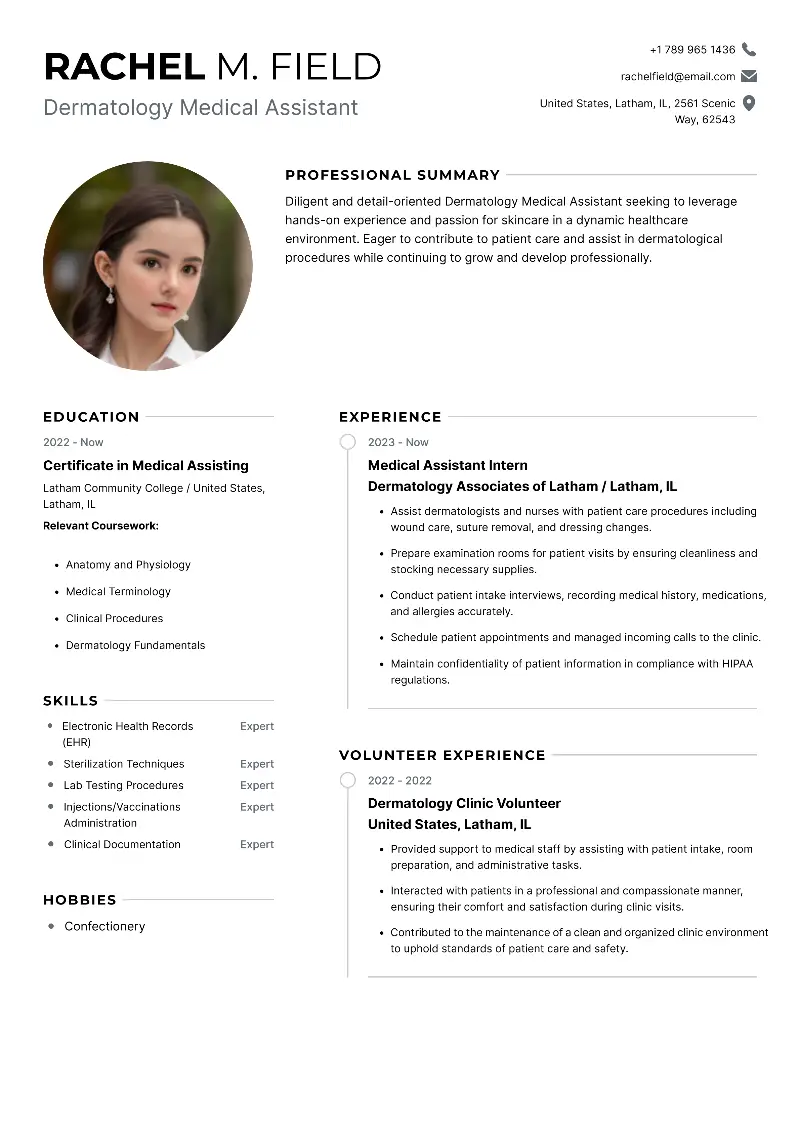Medical assistants play a vital role in the healthcare industry, supporting physicians, nurses, and other staff to ensure smooth patient care.
While many specialists obtain licenses to enhance their skills and career opportunities, there are also numerous non-certified medical assistant jobs.
These positions allow individuals to work in healthcare settings without formal certification, gaining hands-on experience and contributing to patient care in various capacities.
In this article, we'll explore the types of hospital jobs without certification available. We'll review their responsibilities, and how people can pursue a fulfilling career in this growing field.
List of Non-Certified Medical Assistant Jobs
1. Clinical Unlicensed Medical Assistant
Such specialists work in hospitals, clinics, or outpatient centers, assisting doctors and nurses in providing direct patient care. They are in high demand as healthcare facilities need extra hands to manage patient flow, making this an ideal entry-level post.
Often positioned in fast-paced examination wings.
Non-certified clinical medical assistants often work under the supervision of licensed healthcare providers and can find opportunities in various specialties such as pediatrics, cardiology, or internal medicine.
Responsibilities:
- Taking patient vitals (blood pressure, temperature, heart rate)
- Preparing exam rooms and sterilizing instruments
- Assisting physicians with minor procedures
- Collecting lab samples (e.g., blood or urine)
- Recording patient medical histories
- Providing basic education on routine care and procedures
Career Path: Many uncertified medical assistants go on to obtain formal trainings to boost their prospects. They can become CMAs or specialize further as phlebotomists, EKG technicians, or even registered nurses (RNs).
On average, non-certified clinical medical assistants earn between $28,000 and $35,000 per year.
Requirements:
- High school diploma or GED
- Previous experience in healthcare or customer service is an advantage
2. Uncertified Administrative Medical Assistant
They work primarily in the front office of medical facilities, such as physician practices, hospitals, or urgent care centers.
These professionals thrive in places that require multitasking under pressure.
They handle the non-clinical aspects of patient care, helping ensure the smooth operation of the healthcare environment.
Responsibilities:
- Scheduling patient appointments and managing calendars
- Answering phone calls and handling inquiries
- Maintaining records and filing medical documents
- Processing insurance claims and billing
- Greeting patients and managing check-in/check-out procedures
- Coordinating communication between visitors and healthcare providers
Career Path: Can advance by specializing in areas like medical billing and coding. With further education, they can also transition into office management.
Non-certified administrative medical assistants earn between $30,000 and $36,000 annually, with potential increases based on experience and skills.
Requirements:
- High school diploma or GED.
- Good organizational skills, basic computer skills and knowledge, and experience in customer service are key for this role.
- Knowledge of medical billing software or HIPAA regulations is beneficial.
3. Unlicensed Phlebotomy Medical Assistant (Technician)
Phlebotomy technicians work in hospitals, diagnostic labs, and donation centers, where they are responsible for drawing blood from patients for testing.
Handle cold-chain specimen transport containers.
Although license is common in this field, many facilities allow non-certified technicians to start with on-the-job training, especially in high-demand settings such as hospitals.
Responsibilities:
- Taking blood using venipuncture techniques
- Properly labeling blood samples and ensuring they are done correctly
- Maintaining patient safety and comfort during the procedure
- Entering patient data into lab systems
- Assisting with lab work as needed
- Ensuring compliance with safety and infection control protocols
Career Path: Technicians can become certified to increase their earning potential and job security. Some advance into supervisory roles or choose to specialize further in areas such as laboratory technology.
Phlebotomy technicians earn around $25,000 to $32,000 per year, with higher wages in large urban hospitals.
Requirements:
- High school diploma or GED.
- Candidates with experience in healthcare environments or patient care are often preferred.
4. Non-Certified Medical Office Assistant
Such assistants work in the front-end operations of clinics, physician offices, and outpatient centers, often as the first point of contact for patients.
Their daily task revolves around structured routines and customer-facing interaction.
They handle various clerical tasks, ensuring that both patients and medical staff can focus on healthcare delivery.
Responsibilities:
- Receiving phone calls and directing patients
- Filing insurance claims and processing patient paperwork
- Planning and managing patient flow
- Maintaining office supplies and ensuring the office is organized
- Handling correspondence, billing, and data entry
- Supporting staff with administrative tasks such as scheduling and documentation
Career Path: Assistants can progress by taking courses in billing and coding, or pursue certification. They can also advance to office manager positions or transition into healthcare administration roles.
Uncertified medical office assistants earn between $26,000 and $34,000 annually, depending on location, experience, and the type of healthcare facility.
Requirements:
- High school diploma or GED.
- Strong communication and organizational skills are essential.
- Some employers may require knowledge of medical office software.
5. Patient Care Technician (Non-Certified)
These unlicensed medical assistants work in hospitals, nursing homes, and long-term care facilities. They provide direct care to patients under the supervision of registered nurses.
The atmosphere is physically demanding and emotionally intimate.
Responsibilities:
- Monitoring vital signs and reporting changes to nursing staff
- Aiding in patient transfer and repositioning
- Helping with wound care or administering medication
- Maintaining patient records
- Assisting patients with hygiene and comfort needs
Career Path: Many PCTs choose to become certified assistants or pursue further education to be a licensed practical nurse. This role provides valuable experience in direct patient care, which can be foundational for many healthcare careers.
Patient care technicians typically earn between $26,000 and $32,000 per year.
Requirements:
- High school diploma or GED.
- Those with prior healthcare experience or familiarity with patient care environments are preferred.
6. Uncertified Chiropractic Assistant
Non-certified medical assistants work in chiropractic offices, assisting in the day-to-day operations and patient care. With the increasing popularity of alternative and complementary medicine, the demand for chiropractic assistants is on the rise.
Set within calm and therapeutic offices.
Responsibilities:
- Assisting with patient intake and preparing them for chiropractic treatments
- Scheduling appointments and managing patient records
- Educating patients about treatment plans and exercises
- Performing basic therapeutic tasks under supervision, such as applying heat or ice packs
- Managing office supplies and billing
- Supporting practitioners with therapeutic equipment setup and maintenance
Career Path: Can pursue further training in physical therapy or chiropractic care, or transition into office management positions.
Chiropractic assistants receive between $25,000 and $33,000 annually, depending on experience and the size of the practice.
Requirements:
- High school diploma or GED.
- Strong communication skills and an interest in holistic healthcare.
7. Unlicensed Home Medical Assistant
These health aides work in patients' homes, providing essential care and support for individuals who need help with daily living activities.
Frequent adjustments to lighting, layout, or mobility aids are necessary.
Such non-certified medical assistants are in high demand due to the growing elderly population and the rising trend of home-based healthcare services. They are vital in ensuring that patients receive the care while maintaining a sense of independence.
Responsibilities:
- Assisting patients with daily activities like bathing, dressing, and grooming
- Monitoring patient health, including checking vital signs
- Administering basic medication under supervision
- Helping with light housekeeping and meal preparation
- Offering companionship and emotional support
- Reporting any changes in patient condition to supervising nurses or caregivers
Career Path: Can transition to CHHAs or CNAs to increase their earnings and responsibilities. With further study, some move into roles as licensed practical nurses.
Home health aides earn between $23,000 and $30,000 per year, with opportunities for higher wages in specialized care or private duty settings.
Requirements:
- High school diploma, though some employers may not have formal education requirements.
8. Optometric Non-Certified Jobs
Optometric assistants work in eye care clinics, helping optometrists with both medical and administrative tasks.
Assistants operate in well-lit vision centers or specialty retail corners.
Responsibilities:
- Assisting with eye exams and preparing patients for vision tests
- Helping patients choose eyeglass frames and fitting them
- Managing insurance paperwork and billing
- Cleaning and organizing optical equipment
- Maintaining inventory of optical supplies and equipment
Career Path: Assistants may become certified by pursuing further training, which can allow them to take on more clinical tasks. Some may also advance to roles as opticians or ophthalmic technicians.
Non-certified medical assistants typically earn between $24,000 and $32,000 per year, depending on their level of experience and location.
Requirements:
- High school diploma or GED.
- Good interpersonal skills, attention to detail.
- Basic knowledge of vision care.
9. Unlicensed Rehabilitation Medical Assistant
Rehabilitation aides work in therapy clinics, hospitals, and centers, assisting physical and occupational therapists with patient care. Non-certified medical assistants play a crucial role in helping patients recover from injuries or surgeries.
Often moving between therapy stations, they assist in settings where space and timing are critical.
Responsibilities:
- Setting up equipment for therapy sessions
- Assisting patients with exercises under therapist supervision
- Cleaning and maintaining therapy equipment
- Documenting patient progress and reporting to therapists
- Helping with patient transfers and mobility
- Ensuring therapy areas are safe and well-organized
Career Path: Further education and training can lead to careers as physical therapists or other specialized healthcare providers.
Rehabilitation aides earn between $24,000 and $31,000 annually.
Requirements:
- High school diploma or GED.
- An interest in physical therapy, good communication skills, and a willingness to work closely with patients.
FAQ on Medical Jobs Without Certification
- Are there any medical jobs that don’t require a high school diploma?
- While most medical assistant jobs with no certification require at least a high school diploma, some entry-level positions, such as home health aides, may not have such requirements.
- Are there any disadvantages to working in a medical job without certification?
- The primary disadvantage is that these roles often have lower salaries. Additionally, some employers may prefer candidates with certifications, especially in more competitive job markets.
- Can a non-certified medical assistant transition into other healthcare careers?
- Yes, for example, you could move into roles like medical office management, healthcare administration, or pursue additional education to become a nurse or phlebotomist.
- Can an unlicensed medical assistant work in hospitals or only in smaller healthcare settings?
- They can work in both hospitals and small settings, such as clinics, private practices, and urgent care centers. However, hospitals might have stricter requirements and may prefer or require certifications for certain roles, particularly those involving complex medical procedures.
Conclusion
Non-certified medical assistant jobs provide a valuable entry point into the healthcare field for individuals seeking to make a meaningful impact without undergoing formal education.
While the salaries may start at a modest level, many of these positions offer career opportunities through further training, certifications, or on-the-job growth.
Whether as a stepping stone to a more advanced role or a fulfilling career in its own right, uncertified medical assistant jobs play a critical role in ensuring the smooth operation of healthcare facilities and the well-being of patients.
Create your professional Resume in 10 minutes for FREE
Build My Resume





